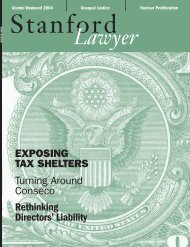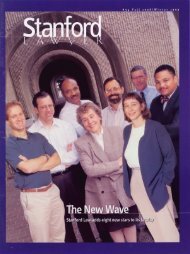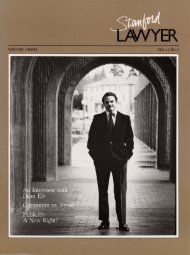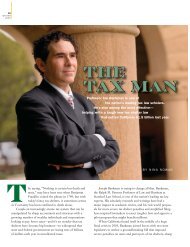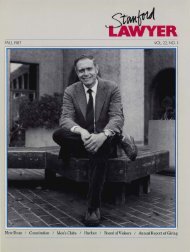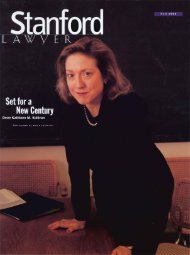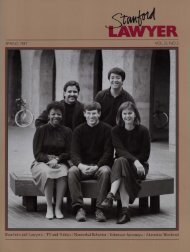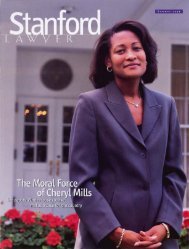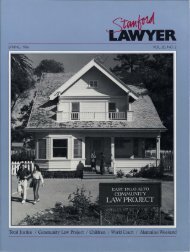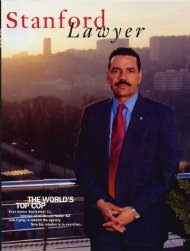Issue 73 - Stanford Lawyer - Stanford University
Issue 73 - Stanford Lawyer - Stanford University
Issue 73 - Stanford Lawyer - Stanford University
Create successful ePaper yourself
Turn your PDF publications into a flip-book with our unique Google optimized e-Paper software.
FROM THE DEAN<br />
Leading the Way in Law and Technology<br />
BY LARRY KRAMER<br />
Richard E. Lang Professor of Law and Dean<br />
3<br />
STANFORD<br />
LAWYER<br />
Historians have identified two economic upheavals<br />
that reshaped the world: the agricultural revolution<br />
and the industrial one. We are now living<br />
through a third such upheaval: an information/<br />
technology revolution that is remaking our lives<br />
and our world in ways every bit as profound as its predecessors.<br />
<strong>Stanford</strong> <strong>University</strong> and its law school, located in<br />
the heart of the Silicon Valley, lie at this revolution’s epicenter.<br />
And this issue of <strong>Stanford</strong> <strong>Lawyer</strong> touches on just a<br />
few of the myriad ways in which <strong>Stanford</strong> Law School has<br />
become the world’s premier place for teaching and scholarship<br />
about the legal dimensions of new technology and<br />
the astonishing, often perplexing, society it is creating.<br />
Our importance in shaping that society is evident on the<br />
cover, which vividly portrays the central role of <strong>Stanford</strong> law<br />
alumni in the world of high-tech business—from William<br />
Neukom ’67, a pioneer at Microsoft, to David Drummond ’89,<br />
who helped bring Google into existence. Nor does <strong>Stanford</strong>’s<br />
dominance in the world of technology end in-house. <strong>Stanford</strong><br />
alumni are also CEOs and managing partners of the leading<br />
law firms that serve the technology industry, including<br />
John Roos ’80 at Wilson, Sonsini; Gordon Davidson ’74 at<br />
Fenwick & West; Stephen Neal ’<strong>73</strong> at Cooley, Godward;<br />
Mary Cranston ’75 at Pillsbury, Winthrop; and many others.<br />
There is a reason <strong>Stanford</strong> law graduates have risen to such<br />
prominence, and it has to do with more than location. The law<br />
school’s position as the unquestioned leader in law and technology<br />
rests on a substantive program that melds theoretical<br />
insight and practical experience in unique ways. That program<br />
begins with what is by far the best intellectual property faculty<br />
in the world, including John H. Barton ’68, international patent<br />
and technology law; Paul Goldstein, copyright and competition<br />
law; Henry T. “Hank” Greely (BA ’74), biotechnology,<br />
biomedical ethics, and health law; Mark A. Lemley (BA<br />
’88), patent, copyright, and antitrust law; Lawrence Lessig,<br />
cyberlaw, copyright, and constitutional law; and Margaret Jane<br />
Radin (BA ’63), e-commerce and property theory.<br />
These faculty have extended their work and enlarged<br />
their influence by establishing centers and programs that<br />
bring scholars, practitioners, and policymakers from around<br />
the world to work together and with our students. Under<br />
the umbrella of our flagship Program in Law, Science &<br />
Technology, directed by Professor Lemley, the law school<br />
also sponsors the Center for E-Commerce, directed by<br />
Professor Radin; the Center for Internet and Society,<br />
directed by Professor Lessig; the Center for Law and the<br />
Biosciences, directed by Professor Greely; and the <strong>Stanford</strong><br />
Center for Computers and Law, a multidisciplinary research<br />
laboratory (the first of its kind) run jointly by the law school<br />
and the Department of Computer Science.<br />
These centers hold conferences, symposia, and seminars;<br />
sponsor fellowships and speakers’ series; support cuttingedge<br />
scholarship; and engage in important public policy and<br />
legislative work—making <strong>Stanford</strong> Law School an unparalleled<br />
hub of activity in the world of technology and the law.<br />
In addition, the Center for Internet and Society runs a clinic<br />
that offers <strong>Stanford</strong> law students the chance to work on litigation<br />
projects that are already reshaping the legal landscape.<br />
Nor is our reach limited to the United States, as evidenced<br />
by the new Transatlantic Technology Law Forum, a joint venture<br />
with the <strong>University</strong> of Vienna School of Law that develops<br />
innovative solutions to European Union–United States<br />
technology law and policy challenges; and by the project to<br />
study intellectual property infrastructures in Asia. This project,<br />
guided by Professor Goldstein, teams <strong>Stanford</strong> students<br />
and scholars with students and scholars from Asia and from<br />
Germany’s Max Planck Institute for Intellectual Property.<br />
I cannot possibly do justice to all these flourishing<br />
activities, or even adequately describe them, in a short letter.<br />
But there is more, or rather more coming, for the law<br />
school has only just begun to explore ways in which to collaborate<br />
better with other parts of the university, including<br />
<strong>Stanford</strong>’s top-rated School of Engineering and School of<br />
Medicine, the multidisciplinary Bio-X initiative, and the<br />
new Department of Bioengineering. We are, for example,<br />
planning to create innovative courses that team law students<br />
with students from business and engineering to work<br />
through the process of creating a new product or company<br />
from invention to market. We are looking into the possibility<br />
of joint degrees with engineering, bioengineering,<br />
and possibly medicine—degrees that could be modeled on<br />
our successful JD/MBA but completed in less time. And<br />
scholars and students from other parts of the university<br />
have begun talking to us about joint research and teaching.<br />
With a year under my belt, I can report that I have loved<br />
being at <strong>Stanford</strong> Law School for the seriousness and integrity<br />
of the faculty and students and for the ambition and<br />
adventurousness of the university. Though ranked as one<br />
of the top universities in the world, this is not a place where<br />
people sit on their laurels or on tradition. Amazing things<br />
are going to happen here in the next decade, especially in<br />
law and technology. We want you to be part of them.





